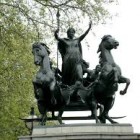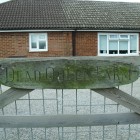A Queen and Milton Keynes, - Vince Moxon
A Queen,& Milton Keynes
A Queen has graced what is now Milton Keynes, In AD 60, Boudicca’s husband, Prasutagus, was ruler of the Iceni tribe, these were a tribe of Celtic Britons, living in and around where Norfolk is today,
The Romans had arrived in England in AD 43, and had largely taken over England by force and ruled from several strongholds namely, Colchester, (Camulodunm), and London, (Londinium), St Albans, (Verulanium), with several smaller towns & villages along the old Roman road (Watling Street) I.E. Fenny Stratford, (Magnavinium) , and Towcester,
In AD 60, Prasutagus, dies, and by Celtic law his estate & lands were to have bequeathed to his wife, but the Romans decreed, that they would take over his land and his camp. Boudicca, strongly resisted any attempted to achieve this and as a reprisal, the Romans, had her publicly flogged and had both of her daughters raped.
Boudicca, took her fighting force and gathered another tribe that had been displaced by the Romans, the Trinovante’s and marched on Colchester, looking for the Roman governor, Suetonius, who ,had ordered her flogging, but he had marched a garrison, to quell, a tribe of rebellious druids in Anglesea,
So Boudicca, realising that anyone remaining in Colchester were sympathisers, burned Colchester to the ground and slaughtered everyone there, about 15,000. And then marched her tribe to London believing Suetonius was in London once again burned London to the ground and slaughtered everyone there, and marched on to St Albans and similarly burned this to the ground and also slaughtered everyone there also, in all about 80.00 people. Suetonius, on hearing of the revolt, marched his garrison of approximately 10.000, men, towards London on the A5.
Boudicca, not having achieved her objectives of ridding the country of Suetonius and the Romans, and hopeful of meeting his army coming down Watling Street, the opposing armies met at Cuttle Mill just south of Towcester.
The Romans, although outnumbered, 3 to 1, highly trained in warfare, and were heavily armed with cannons etc.
(This event is covered extensively in a large room devoted to Boudicca & the battle in Towcester museum.)
Boudiccas forces (mostly women) were easily repressed and Boudicca was wounded, not to be taken prisoner, she fled the scene and turned south down Watling Street towards Magnovinium, (Fenny Stratford). But she never made it, and died of her injuries at a small group of hamlets near Newton Longville, and a house named in her honour “Dead Queen Cottage”, the present day owner had a farm house built nearby and transferred the name as it is now to, “Dead Queen Farm” on the Bletchley to Newton Longville Road.








Comments about this page
You need to be aware that there are no surviving first hand accounts. Third hand at best. If the final battle was fought in a confined space then any cavalry present would have been dismounted and held in the rear. There were no flanks which was the whole point of the romans choosing that position in the first place. It is likely that after a bloody slog by both sides the romans judged themselves to be fit enough relative to the state of the britons to move down the slope without fear of any flanking movements. They would be waiting for the enemy to break off and flee and only at this point would mounted troops be employed.
Only two Roman writers mention the battle, nothing was recorded by them as to where the battle took place and no archaeological evidence has been unearthed to identify either it, what happened to Boudica, or indeed the nature of her death.
The idea that a cottage outside Newton Longville, even a medieval one, would be linked to the death of a leader of the Iceni who died in AD61, potentially 1500 years earlier, is to say the least far fetched.
Boudica being such an iconic figure I think it’s likely that previous historians might have mentioned it?
As to the author believing the Romans had cannons, seriously, I think a little fact checking might have given the piece rather more credibility.
There’s a place called Battleden in Milton Keynes between A5 Watling Street and Woburn Abbey may have been the site !!!
There is a farm close to one of the Brickhills called Battle Hills farm….
This “history” is mostly fantasy. The romans did not have cannons. They did have ballistae, which are large wheeled crossbows, but these were siege weapons, There is no evidence that the Celtic army were mostly female, and the battle could have happened anywhere between Fenny Stratford and Daventry. Since there is another legend that Boudicca is buried under a platform at St Pancras (seriously!) even the location of her death seems to be confused. Finally to the comment above, you’d be looking North from little Brickhill, not South.
“Paulinus met the Britons at a point thought to be near present-day Fenny Stratford on Watling Street and in a desperate battle regained the province. Boudicca took poison or died of shock”. Well that’s what Encyclopaedia Britannica says. But at little Brick Hill looking south you may be inspired that, maybe, her warring maidens lost this battle – just there below you.
Add a comment about this page